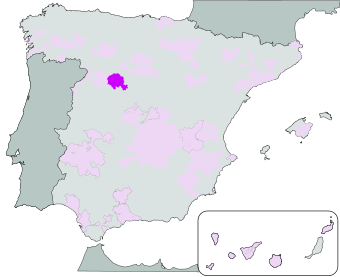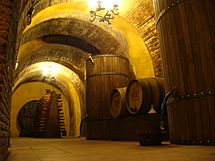Rueda (DO) facts for kids
| Wine region | |

|
|
| Official name | D.O. Rueda |
|---|---|
| Type | Denominación de Origen Protegida (DOP) |
| Year established | 1980 |
| Country | Spain |
| Size of planted vineyards | 16,164.92 hectares (39,944 acres) |
| No. of wineries | 68 |
| Wine produced | 678,889 hectolitres (14,933,500 imp gal; 17,934,400 US gal) |
| Comments | Data for 2016 / 2017 |
Rueda is a special area in Spain known for making wine. It has a special title called "Denominación de Origen Protegida" (DOP). This means its wines are protected and must follow certain rules.
Rueda is located in the Castile and León region of Spain. It includes 72 towns. Most of these towns are in the Valladolid area. Some are also in Segovia and Ávila. Rueda is famous for its white wines. These wines are mostly made from a grape called Verdejo.
Contents
History of Rueda Wines
People have been making wine in the Rueda area for a very long time. The first records of wine production are from the 11th century. Back then, King Alfonso VI gave land to new settlers. Many people and religious groups started farms with their own vineyards.
In the 1700s, there were even more grapevines than today. Almost all of them were the Verdejo grape. The wines from Rueda were very popular. This was partly because they used local clay to make the wine clear.
Between 1890 and 1922, a tiny bug called phylloxera caused big problems. This bug destroyed more than two-thirds of the grapevines. Farmers had to replant their vineyards. They did this by joining new grapevines onto special roots from the New World. These roots were strong and could fight off the bug.
However, the new grape types were chosen because they grew a lot of grapes, not because they made the best wine. For many years, the wine was sold in large amounts, not in bottles. The local Verdejo grape almost disappeared.
Luckily, a local winemaker named Ángel Rodríguez Vidal helped save the Verdejo grape. He worked hard to bring it back. Because of his efforts, he received a special award from King Juan Carlos I of Spain.
People first thought about making Rueda a special wine region in 1935. But it took many years. In 1972, a big winery from Rioja, Marqués de Riscal, invested a lot of money. This helped Rueda start making high-quality wines again, focusing on the Verdejo grape. Rueda officially became a DOP in 1980.
Where Rueda Is Located
The Rueda wine region covers about 16,165 hectares (about 40,000 acres). It is centered around the town of Rueda. This town is in the Valladolid province. It is about 170 kilometers (105 miles) northwest of Madrid.
The land in Rueda is a flat, high plain. It is between 600 and 780 meters (1,970 to 2,560 feet) above sea level. The Duero River flows through the area from east to west.
Rueda's Climate
Rueda has a continental climate. This means it has long, hot summers and cold winters. It also gets some influence from the Atlantic Ocean. Temperatures can change a lot. In winter, it can drop to -1°C (30°F). In summer, it can reach 30°C (86°F). These summer temperatures are not as hot as some other wine regions in central Spain.
In winter and spring, there is a risk of frost, freezing fog, strong winds, and hailstones. However, there is very little chance of a drought. It usually rains in spring and autumn. The area gets about 400 millimeters (16 inches) of rain each year. The grapevines also get about 2,700 hours of sunlight every year.
Rueda's Soils
Near the Duero River, the soil is made of river deposits. It has a lot of lime. To the south, the top layer of soil is brown and sandy. Below that, there is a mix of gravel and clay. The soil drains water well. It also has a lot of iron and is easy to farm.
Types of Grapes in Rueda
Rueda uses several types of grapes to make its wines.
- White Grapes: The main white grapes allowed are Verdejo, Viura, and Sauvignon blanc. Another grape called Palomino Fino is also used. More recently, other grapes like Viognier and Chardonnay have also been approved.
- Red Grapes: The red grapes allowed are Tempranillo, Cabernet Sauvignon, Merlot, Syrah, and Garnacha.
Farmers are allowed to grow up to 8,000 kilograms of white grapes per hectare (about 7,100 pounds per acre). If the vines are grown on special frames called trellises, they can grow up to 10,000 kilograms per hectare. But in reality, farmers usually grow much less than this.
Most new vineyards have rows of grapevines spaced 3 meters (10 feet) apart. This allows machines to work in the fields. Farmers can only water their vines in special situations. Grapevines are often grown close to the ground. This helps them stand strong against the area's powerful winds.
How Rueda Wines Are Classified

Rueda makes white, rosé (pink), and red wines. They have different names based on how they are made:
- Rueda: These are white wines. They must be made with at least 50% of the main grapes from the region. These main grapes are Verdejo and Sauvignon Blanc.
- Vino de Pueblo: This means "Village Wine." These wines can show the name of the village or town where the grapes were grown. This is allowed if more than 85% of the grapes come from that specific place.
- Gran Vino de Rueda: This is the most special type of Rueda wine. The grapes for these wines must come from vineyards that are more than 30 years old. These vineyards produce fewer grapes, but the grapes are very high quality.
See also
 In Spanish: Rueda (vino) para niños
In Spanish: Rueda (vino) para niños
- Spanish wine
- Cuisine of Valladolid

